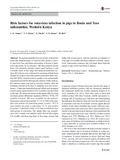| dc.contributor.author | Amimo, J. O. | |
| dc.contributor.author | Otieno, T. F. | |
| dc.contributor.author | Okoth, E. | |
| dc.contributor.author | Onono, J. O. | |
| dc.contributor.author | Bett, B. | |
| dc.date.accessioned | 2017-05-03T06:45:11Z | |
| dc.date.available | 2017-05-03T06:45:11Z | |
| dc.date.issued | 2017 | |
| dc.identifier.uri | http://link.springer.com/article/10.1007/s11250-016-1164-9 | |
| dc.identifier.uri | http://hdl.handle.net/11295/100780 | |
| dc.description.abstract | We analysed data that were previously collected for molecular characterisation of rotavirus (RV) groups A and C in pigs from Teso and Busia subcounties in Kenya to determine risk factors for its infection. The data included records from 239 randomly selected piglets aged between 1 and 6 months raised in free range and backyard production systems. RV infection was confirmed by screening of fresh faecal samples by using reverse transcription polymerase chain reaction (RT-PCR); selected positive samples were subsequently sequenced and used for phylogenetic analysis. In this analysis, RV infection status was used as outcome variable, while the metadata collected at the time of sampling were used as predictors. A Bayesian hierarchical model which used integrated nested Laplace approximation (INLA) method was then fitted to the data. The model accounted for the spatial effect by using stochastic partial differential equations (SPDEs). Of the 239 samples screened, 206 were available for the analysis. Descriptive analyses showed that 27.7 % (57/206) of the samples were positive for rotaviruses groups A and C, 18.5 % were positive for group A rotaviruses, 5.3 % were positive for group C rotaviruses, while 3.9 % had co-infections from both groups of rotaviruses. The spatial effect was insignificant, and a simple (non-spatial) model showed that piglets (≤4 months) and those pigs kept in free range systems had higher risk of exposure to rotavirus infection as compared to older pigs (>4 months) and those tethered or housed, respectively. Intervention measures that will target these high-risk groups of pigs will be beneficial to farmers. | en_US |
| dc.language.iso | en | en_US |
| dc.publisher | University of Nairobi | en_US |
| dc.rights | Attribution-NonCommercial-NoDerivs 3.0 United States | * |
| dc.rights.uri | http://creativecommons.org/licenses/by-nc-nd/3.0/us/ | * |
| dc.subject | Rotaviruses A and C Smallholder pigs Western Kenya INLA Risk factors | en_US |
| dc.title | Risk factors for rotavirus infection in pigs in busia and Teso Subcounties, western Kenya | en_US |
| dc.type | Article | en_US |



